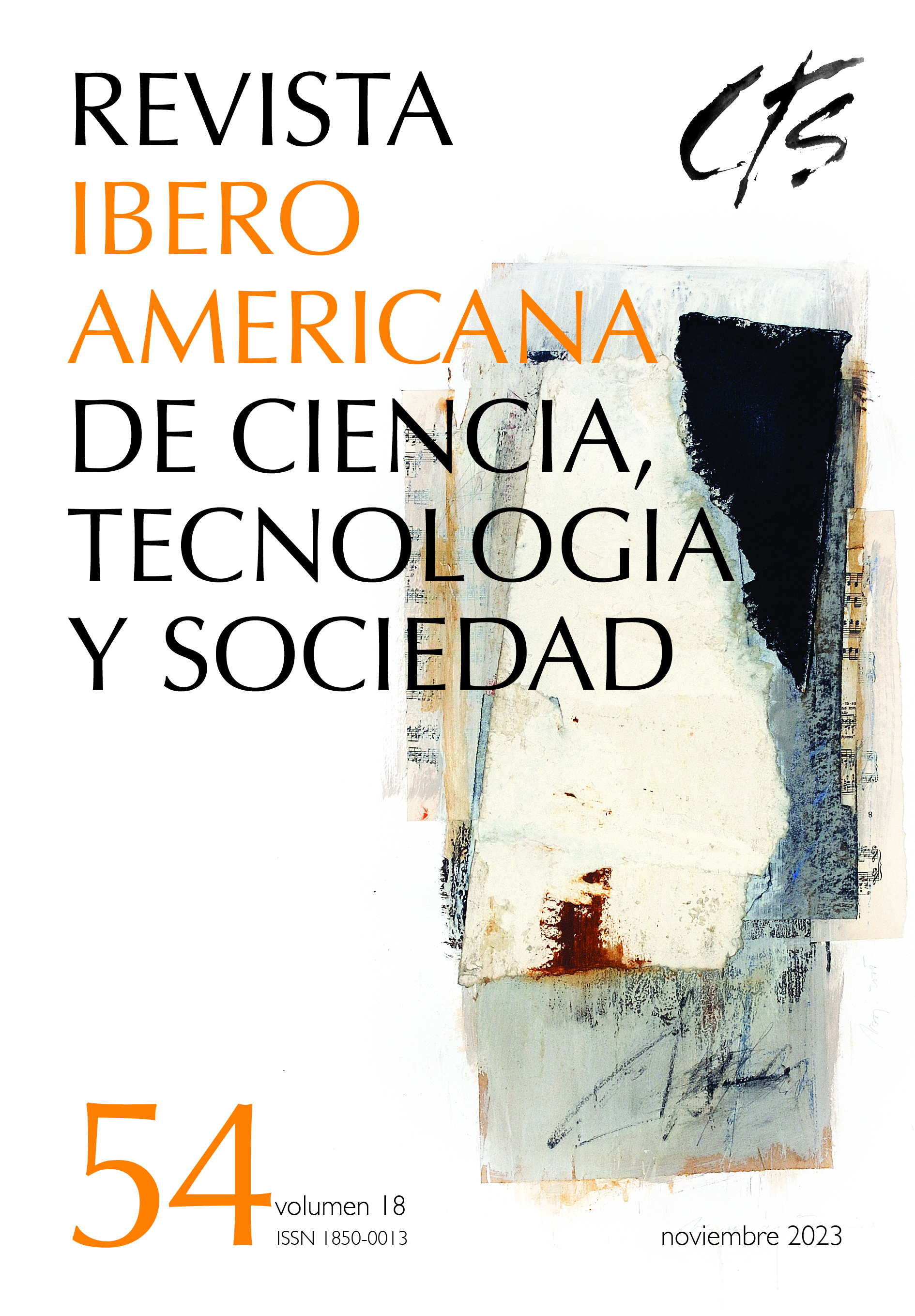Relationship with Industry and Intellectual Benefits for Science
Joint Research and the Research Service in Argentina
DOI:
https://doi.org/10.52712/issn.1850-0013-482Keywords:
science, industry, knowledge, cooperation, learningAbstract
This article investigates the effects that joint research and research service, as relational schemes of collaboration with industry, generate in public research. Based on the contributions that the industry makes, it is analyzed how they are linked to public learning and to the direction of research. A case study was carried out in three sectors - agrobiotechnology, biopharmaceutical and nanotechnology - of a developing country like Argentina. Among the main findings, it stands out that industrial contributions allow public researchers to absorb new capacities, provide applied research with greater economic and social relevance, and generate feedbacks on more basic aspects of their activity.
Downloads
References
Abreu, M. & Grinevich, V. (2013). The nature of academic entrepreneurship in the UK: Widening the focus on entrepreneurial activities. Research Policy, 42, 408-422.
Aggio, C., Milesi, D., Verre., Zanazzi, L. & Lengyel, M. (2021). Trayectoria exportadora del sector de arándanos en la Argentina: dinámicas competitivas, tecnológicas y asociativas. Informe Técnico, (16), CIECTI.
Ankrah, S. & Al-Tabbaa, O. (2015). Universities–industry collaboration: a systematic review. Scandinavian Journal of Management, 31, 387–408.
Arocena, R. & Sutz, J. (2005). Latin American Universities: From an original revolution to an uncertain transition. Higher Education, 50(4), 573-592.
Arza, V. & Carattoli, M. (2017). Personal ties in university-industry linkages: A case-study from Argentina. The Journal of Technology Transfer, 42, 814-840.
Bonaccorsi, A. & Piccaluga, A. (1994). A theoretical framework for the evaluation of university-industry relationships. R&D Management, 24(3), 229–247.
Bruneel, J., D’Este, P. & Salter, A. (2010). Investigating The Factors That Diminish The Barriers To University-Industry Collaboration. Research Policy, 39(7), 858-868.
Cohen, W. M., Nelson, R. R. & Walsh, J. P. (2002). Links and impacts: the influence of public research on industrial R&D. Management Science, 48(1), 1-23.
D'Este, P. & Patel, P. (2007). University-industry linkages in the UK: What are the factors determining the variety of interactions with industry? Research Policy, (36)9, 1295-1313.
D'Este, P. & Perkmann, M. (2011). Why do academics engage with industry? The entrepreneurial university and individual motivations. Journal of Technology Transfer, 36(3), 316-339.
D’Este, P., Llopis, O., Rentocchini, F. & Yegros, A. (2019). The relationship between interdisciplinarity and distinct modes of university-industry interaction. Research Policy, 48, 103799.
Freeman, C. (2004). Technological infrastructure and international competitiveness. Industrial and Corporate Change, 13(3), 541-569.
Gulbrandsen, M. & Smeby, J. C. (2005). Industry funding and university professors’ research performance. Research Policy, 34(6), 932–950.
Gutman, G. & Lavarello, P. (2011). Formas de organización de las empresas biotecnológicas en el sector farmacéutico argentino. Desarrollo Económico, 51(201), 81-104.
Hughes, A., Ulrichsen, T. & Moore, B. (2010). Synergies and tradeoffs between research, teaching and knowledge exchange. A report to HEFCE by PACEC and the Centre for Business Research. Cambridge: University of Cambridge.
Laursen, K. & Salter, A. (2006). Open for innovation: the role of openness in explaining innovation performance among U.K. manufacturing firms. Strategic Management Journal, 27(2), 131-150.
Mansfield, E. (1995). Academic research underlying industrial innovations: Sources, characteristics, and financing. The Review of Economics and Statistics, 77(1), 55–65.
Meyer-Krahmer, F. & Schmoch, U. (1998). Science-based technologies: university–industry interactions in four fields. Research Policy, 27(8), 835-851.
Milesi, D., Aggio, C., Verre, V. & Lengyel, M (2020). Acumulación de capacidades tecnológicas y especialización productiva: el rol potencial de las actividades basadas en recursos naturales. Documento de Trabajo, (14), CIECTI.
Nelson, R. (1993). National Innovation Systems: A Comparative Study. Oxford: Oxford University Press.
Perkmann, M. & Walsh, K. (2009). The two faces of collaboration: impacts of university-industry relations on public research. Industrial and Corporate Change 18(6), 1033-1065.
Perkmann, M., Neely, A. & Walsh, K. (2011). How should firms evaluate success in university-industry alliances? A performance measurement system. R&D Management, 41(2), 202-216.
Perkmann, M. & West, J. (2014). Open science and open innovation: sourcing knowledge from universities. En A. N. Link, D. S. Siegel & M. Wright (Eds.), The Chicago Handbook of University Technology Transfer and Academic Entrepreneurship (41–74). Chicago: University of Chicago Press.
Perkmann, M., Salandra, R., Tartari, V., McKelvey, M. & Hughes, A. (2021). Academic engagement: A review of the literature 2011–2019. Research Policy, 50(1), 104-114.
Rosenberg, N. & Nelson, R. R. (1994). American universities and technical advance in industry. Research Policy, 23, 323–348.
Schartinger, D., Rammer, C., Fischer, M. M. & Frohlich, J. (2002). Knowledge interactions between universities and industry in Austria: sectoral patterns and determinants. Research Policy, 31(3), 303-328.
Stake, R. (1995). Investigación con estudios de caso. Madrid: Ediciones Morata.
Surtayeva, S. & Hurtado, D. (2019). Cambio tecnológico y capacidades políticas e institucionales: La trayectoria de la Fundación Argentina de Nanotecnología. Revista Estado y Políticas Públicas, 12, 97-122.
Van Looy, B., Callaert, J. & Debackere, K. (2006). Publication and patent behavior of academic researchers: Conflicting, reinforcing or merely co-existing? Research Policy, 35, 596-608.
Verre, V., Milesi, D. & Petelski, N. (2020). Cooperación ciencia-industria: ¿puede aprender también la parte pública? Revista Iberoamericana de Ciencia Tecnología y Sociedad -CTS, 15(43), 11-33. Recuperado de: http://ojs.revistacts.net/index.php/CTS/article/view/142.
Yin, R. K. (2009). Case study research and applications: Design and methods. California: Sage Publications.
Downloads
Published
How to Cite
Issue
Section
License
Copyright (c) 2023 CC Attribution 4.0

This work is licensed under a Creative Commons Attribution 4.0 International License.
All CTS's issues and academic articles are under a CC-BY license.
Since 2007, CTS has provided open and free access to all its contents, including the complete archive of its quarterly edition and the different products presented in its electronic platform. This decision is based on the belief that offering free access to published materials helps to build a greater and better exchange of knowledge.
In turn, for the quarterly edition, CTS allows institutional and thematic repositories, as well as personal web pages, to self-archive articles in their post-print or editorial version, immediately after the publication of the final version of each issue and under the condition that a link to the original source will be incorporated into the self-archive.











